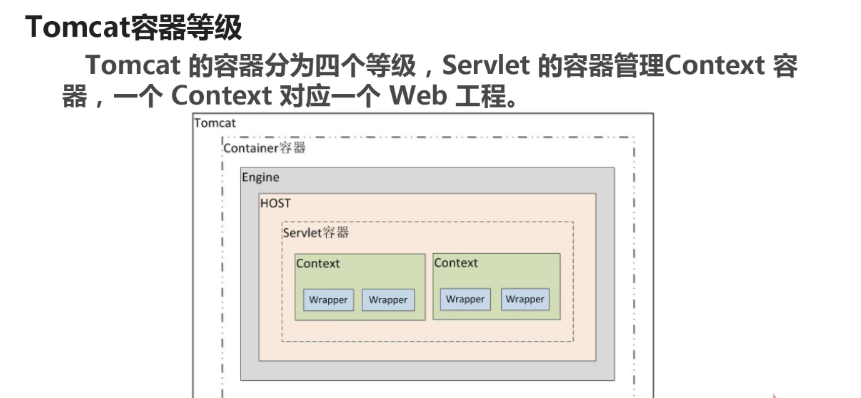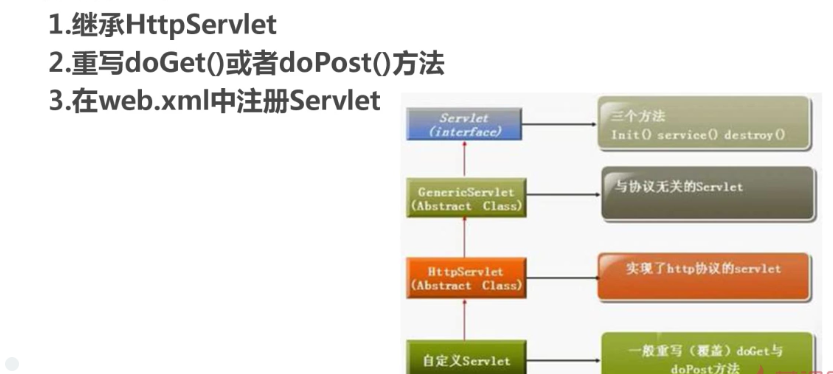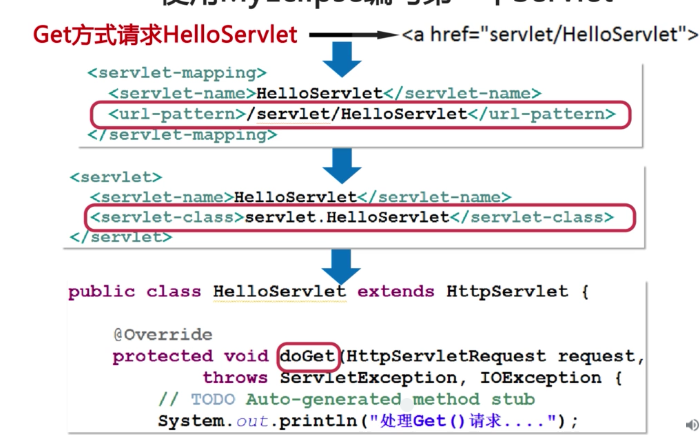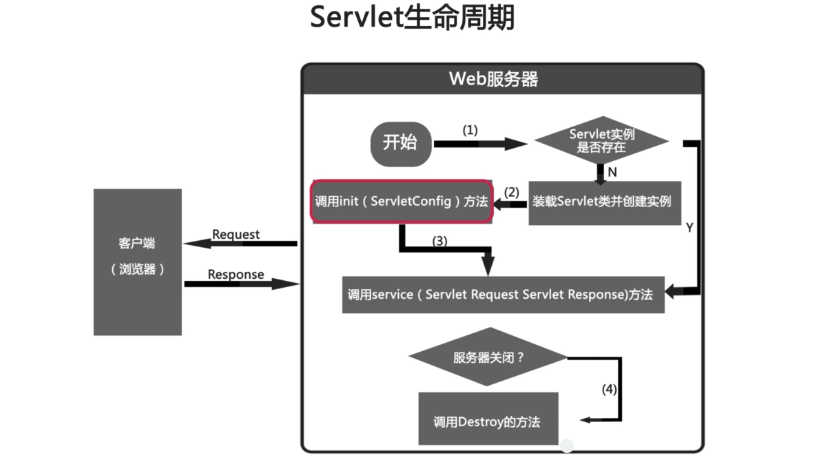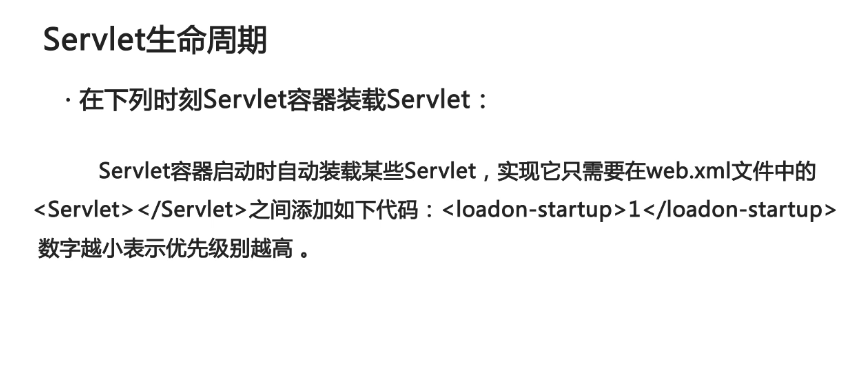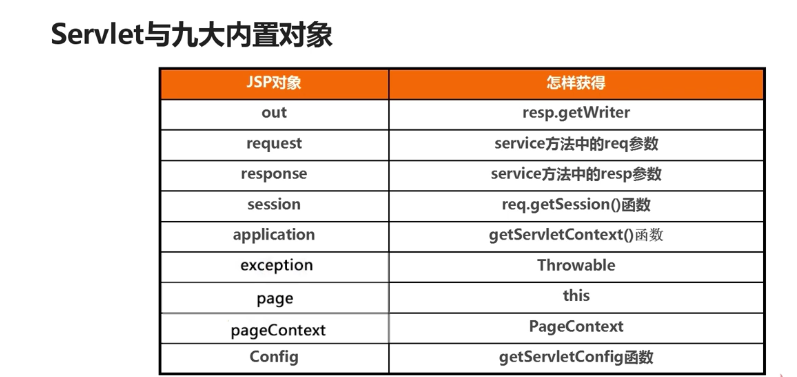jee之servlet学习笔记
1.Servlet概述
答: 详见下图:
2.Tomcat容器等级
答: 详见下图:
3.使用Myeclipse编写Servlet
答:详见下图:如果表单提交时用的是get请求,那么我们就重写doGet()方法!
(1)在jsp页面使用get方式或post方式提交数据给后台servlet
<a href="servlet/HelloServlet">Get方式请求HelloServlet</a><br>
<form action="servlet/HelloServlet" method="post">
<input type="submit" value="Post方式请求HelloServlet"/>
</form>(2)后台的servlet
package servlet;
import java.io.IOException;
import java.io.PrintWriter;
import javax.servlet.ServletException;
import javax.servlet.http.HttpServlet;
import javax.servlet.http.HttpServletRequest;
import javax.servlet.http.HttpServletResponse;
public class HelloServlet extends HttpServlet {
/**
* Constructor of the object.
*/
public HelloServlet() {
super();
}
/**
* Destruction of the servlet. <br>
*/
public void destroy() {
super.destroy(); // Just puts "destroy" string in log
// Put your code here
}
/**
* The doGet method of the servlet. <br>
*
* This method is called when a form has its tag value method equals to get.
*
* @param request the request send by the client to the server
* @param response the response send by the server to the client
* @throws ServletException if an error occurred
* @throws IOException if an error occurred
*/
public void doGet(HttpServletRequest request, HttpServletResponse response)
throws ServletException, IOException {
System.out.println("处理Get请求...");
response.setContentType("text/html");
PrintWriter out = response.getWriter();
out.println("<!DOCTYPE HTML PUBLIC \"-//W3C//DTD HTML 4.01 Transitional//EN\">");
out.println("<HTML>");
out.println(" <HEAD><TITLE>A Servlet</TITLE></HEAD>");
out.println(" <BODY>");
out.println("<strong>Hello Servlet!</strong><br>");
out.println(" </BODY>");
out.println("</HTML>");
out.flush();
out.close();
}
/**
* The doPost method of the servlet. <br>
*
* This method is called when a form has its tag value method equals to post.
*
* @param request the request send by the client to the server
* @param response the response send by the server to the client
* @throws ServletException if an error occurred
* @throws IOException if an error occurred
*/
public void doPost(HttpServletRequest request, HttpServletResponse response)
throws ServletException, IOException {
System.out.println("处理Post请求...");
response.setContentType("text/html");
PrintWriter out = response.getWriter();
out.println("<!DOCTYPE HTML PUBLIC \"-//W3C//DTD HTML 4.01 Transitional//EN\">");
out.println("<HTML>");
out.println(" <HEAD><TITLE>A Servlet</TITLE></HEAD>");
out.println(" <BODY>");
out.println("<strong>Hello Servlet!</strong><br>");
out.println(" </BODY>");
out.println("</HTML>");
out.flush();
out.close();
}
/**
* Initialization of the servlet. <br>
*
* @throws ServletException if an error occurs
*/
public void init() throws ServletException {
// Put your code here
}
}(3)注册servlet
<servlet-mapping>
<servlet-name>HelloServlet</servlet-name>
<url-pattern>/servlet/HelloServlet</url-pattern>
</servlet-mapping>
<welcome-file-list>
<welcome-file>index.jsp</welcome-file>
</welcome-file-list>记得:myeclipse会自动生成;
localhost是服务器主机名,也可以是IP地址127.0.0.1;8080是tomcat服务器的端口号;helloapp是web工程的上下文地址ContexRoot(一般情况下与web工程名一致);最后是<url-pattern/>标签中的内容。
4.Servlet执行流程和声明周期
答:详见下图:
servlet生命周期阶段包括初始化、加载、实例化、服务和销毁。
编写Servlet的doPost方法时,需要抛出ServletExcpetion和IOException异常。
5.Tomcat装载Servlet的三种情况
答:详见下图:记住servlet是长期服务器保存到内存中
(1)随便写一个jsp页面提交你数据给servlet
<body>
<h1>Servlet生命周期</h1>
<hr>
<a href="servlet/TestServlet1">以Get方式请求TestServlet1</a>
</body>(2)要处理的Servlet
package servlet;
import java.io.IOException;
import java.io.PrintWriter;
import javax.servlet.ServletException;
import javax.servlet.http.HttpServlet;
import javax.servlet.http.HttpServletRequest;
import javax.servlet.http.HttpServletResponse;
public class TestServlet1 extends HttpServlet {
/**
* Constructor of the object.
*/
public TestServlet1() {
System.out.println("TestServlet1构造方法被执行....");
}
/**
* Destruction of the servlet. <br>
*/
public void destroy() {
System.out.println("TestServlet1销毁方法被执行....");
}
/**
* The doGet method of the servlet. <br>
*
* This method is called when a form has its tag value method equals to get.
*
* @param request the request send by the client to the server
* @param response the response send by the server to the client
* @throws ServletException if an error occurred
* @throws IOException if an error occurred
*/
public void doGet(HttpServletRequest request, HttpServletResponse response)
throws ServletException, IOException {
System.out.println("TestServlet1的doGet()方法被执行...");
response.setContentType("text/html;charset=utf-8");
PrintWriter out = response.getWriter();
out.println("<!DOCTYPE HTML PUBLIC \"-//W3C//DTD HTML 4.01 Transitional//EN\">");
out.println("<HTML>");
out.println(" <HEAD><TITLE>A Servlet</TITLE></HEAD>");
out.println(" <BODY>");
out.println("<h1>大家好,我是TestServlet1!</h1>");
out.println(" </BODY>");
out.println("</HTML>");
out.flush();
out.close();
}
/**
* The doPost method of the servlet. <br>
*
* This method is called when a form has its tag value method equals to post.
*
* @param request the request send by the client to the server
* @param response the response send by the server to the client
* @throws ServletException if an error occurred
* @throws IOException if an error occurred
*/
public void doPost(HttpServletRequest request, HttpServletResponse response)
throws ServletException, IOException {
System.out.println("TestServlet1的doPost()方法被执行...");
doGet(request,response); //让doPost()执行与doGet()相同的操作。
}
/**
* Initialization of the servlet. <br>
*
* @throws ServletException if an error occurs
*/
public void init() throws ServletException {
// Put your code here
System.out.println("TestServlet1的初始化方法被执行....");
}
}(3)注册Servlet
<?xml version="1.0" encoding="UTF-8"?>
<web-app version="2.5"
xmlns="http://java.sun.com/xml/ns/javaee"
xmlns:xsi="http://www.w3.org/2001/XMLSchema-instance"
xsi:schemaLocation="http://java.sun.com/xml/ns/javaee
http://java.sun.com/xml/ns/javaee/web-app_2_5.xsd">
<display-name></display-name>
<servlet>
<description>This is the description of my J2EE component</description>
<display-name>This is the display name of my J2EE component</display-name>
<servlet-name>TestServlet1</servlet-name>
<servlet-class>servlet.TestServlet1</servlet-class>
<!--
<load-on-startup>2</load-on-startup>
-->
</servlet>
<servlet>
<description>This is the description of my J2EE component</description>
<display-name>This is the display name of my J2EE component</display-name>
<servlet-name>TestServlet2</servlet-name>
<servlet-class>servlet.TestServlet2</servlet-class>
<!--
<load-on-startup>1</load-on-startup>
-->
</servlet>
<servlet-mapping>
<servlet-name>TestServlet1</servlet-name>
<url-pattern>/servlet/TestServlet1</url-pattern>
</servlet-mapping>
<servlet-mapping>
<servlet-name>TestServlet2</servlet-name>
<url-pattern>/servlet/TestServlet2</url-pattern>
</servlet-mapping>
<welcome-file-list>
<welcome-file>index.jsp</welcome-file>
</welcome-file-list>6.Servlet与JSP内置对象的对应关系
答:详见下图:
7.Servlet获取表单数据
答
从客户端获取表单的信息:
package servlet;
import java.io.IOException;
import java.io.PrintWriter;
import java.text.SimpleDateFormat;
import java.util.Date;
import javax.servlet.ServletException;
import javax.servlet.http.HttpServlet;
import javax.servlet.http.HttpServletRequest;
import javax.servlet.http.HttpServletResponse;
import entity.Users;
public class RegServlet extends HttpServlet {
/**
* Constructor of the object.
*/
public RegServlet() {
super();
}
/**
* Destruction of the servlet. <br>
*/
public void destroy() {
super.destroy(); // Just puts "destroy" string in log
// Put your code here
}
/**
* The doGet method of the servlet. <br>
*
* This method is called when a form has its tag value method equals to get.
*
* @param request the request send by the client to the server
* @param response the response send by the server to the client
* @throws ServletException if an error occurred
* @throws IOException if an error occurred
*/
public void doGet(HttpServletRequest request, HttpServletResponse response)
throws ServletException, IOException {
doPost(request,response);
}
/**
* The doPost method of the servlet. <br>
*
* This method is called when a form has its tag value method equals to post.
*
* @param request the request send by the client to the server
* @param response the response send by the server to the client
* @throws ServletException if an error occurred
* @throws IOException if an error occurred
*/
public void doPost(HttpServletRequest request, HttpServletResponse response)
throws ServletException, IOException {
request.setCharacterEncoding("utf-8");
Users u = new Users();
String username,mypassword,gender,email,introduce,isAccept;
Date birthday;
String[] favorites;
SimpleDateFormat sdf = new SimpleDateFormat("yyyy-MM-dd");
try
{
username = request.getParameter("username");
mypassword = request.getParameter("mypassword");
gender = request.getParameter("gender");
email = request.getParameter("email");
introduce = request.getParameter("introduce");
birthday = sdf.parse(request.getParameter("birthday"));
if(request.getParameterValues("isAccpet")!=null)
{
isAccept = request.getParameter("isAccept");
}
else
{
isAccept = "false";
}
//用来获取多个复选按钮的值
favorites = request.getParameterValues("favorite");
u.setUsername(username);
u.setMypassword(mypassword);
u.setGender(gender);
u.setEmail(email);
u.setFavorites(favorites);
u.setIntroduce(introduce);
if(isAccept.equals("true"))
{
u.setFlag(true);
}
else
{
u.setFlag(false);
}
u.setBirthday(birthday);
//把注册成功的用户对象保存在session中
request.getSession().setAttribute("regUser", u);
//跳转到注册成功页面
request.getRequestDispatcher("../userinfo.jsp").forward(request,response);
}
catch(Exception ex)
{
ex.printStackTrace();
}
}
/**
* Initialization of the servlet. <br>
*
* @throws ServletException if an error occurs
*/
public void init() throws ServletException {
// Put your code here
}
}8.Servlet路径跳转:
答:详见下图:
(1)访问那个路径下的servlet:
<body>
<h1>Servlet路径跳转</h1>
<hr>
<!--使用相对路径访问HelloServlet -->
<!-- /servlet/HelloServlet 第一个/表示服务器的根目录 -->
<a href="servlet/HelloServlet">访问HelloServlet!</a><br>
<!-- 使用绝对路径 访问HelloServlet,可以使用path变量:path变量表示项目的根目录-->
<a href="<%=path%>/servlet/HelloServlet">访问HelloServlet!</a><br>
<!--表单中action的URL地址写法,与超链接方式完全相同。 -->
<a href="servlet/TestServlet">访问TestServlet,跳转到Test.jsp</a>
</body>(2)在Servlet里面使用重定向或服务器转发
public void doPost(HttpServletRequest request, HttpServletResponse response)
throws ServletException, IOException {
//请求重定向方式跳转到test.jsp,当前路径是ServletPathDirection/servlet/
//response.sendRedirect("test.jsp");
//使用request.getContextPath获得上下文对象
//response.sendRedirect(request.getContextPath()+"/test.jsp");
//服务器内部跳转,这里的斜线表示项目的根目录
//request.getRequestDispatcher("/test.jsp").forward(request, response);
request.getRequestDispatcher("../test.jsp").forward(request, response);
}共同学习,写下你的评论
评论加载中...
作者其他优质文章



